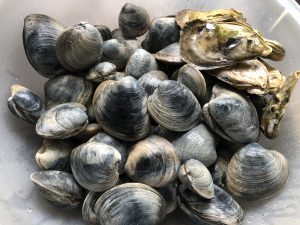 Living on Cape Cod, I get the opportunity to enjoy a lot of seafood year round. And there is nothing better than to grow or catch your own food – you know it’s fresh.
Living on Cape Cod, I get the opportunity to enjoy a lot of seafood year round. And there is nothing better than to grow or catch your own food – you know it’s fresh.
Clams are one food we enjoy collecting and cooking whenever we can. I enjoy making Cape Cod Clam Chowder, Clams with Lemon and Basil and especially my mom’s Denise’s Stuffed Clams. The challenge is to enjoy the clams without the sand they live in.
Here’s what you need to know to get the grit out of your clams.
The vast majority of clams, mussels and oysters you buy in the market have been purged already. You will almost never need to purge your clams if you bought them at a supermarket. If you are not sure, just ask.
If you catch your own clams or buy them directly from a shellfisherman, it might be worth your while to purge the sand out before you cook them.
There is a lot of bad information out there about how to purge sand from clams and it can be difficult to separate the knowledge from the folklore. For example adding corn meal to the purging water does nothing for the clams. The reason they have sand and grit in them is because they live buried in sand or mud.
So here is how you Purge sand from your clams:
Next time you go clamming, bring a 5-gallon bucket and fill it with seawater. The clams will be use to the salinity and temperature of that water. It’s perfect for your needs.
- At home, wash the clams under cold tap water to remove mud or grit on the outside of the shell. Put the clams into a large non-reactive container. I use a big plastic bowl.
- Either let the seawater you brought home settle for 20 minutes or so, or filter it through a paper towel. You want it as grit-free as possible. Pour the water over the clams, covering by 1 to 3 inches. If you are purging especially muddy clams, hold back any remaining seawater — you’ll need to change it in a day. Clams need oxygen in the water and if you are going to purge for more than a few hours you’ll want new saltwater for the bowl.
- Set the clams in the fridge or in a cool place — somewhere where the temperature is reasonably close to the water they were in — and leave for at least an hour, and up to overnight hours. Change the water if you can.
- When you are ready, rinse the clams again. Hard-shelled clams can go into the fridge. Open-shelled clams need to be eaten or thrown out.
You cannot purge a clam in fresh water. Fresh water kills clams. And dead clams are, with few exceptions, no good to eat.
Bill Rice is founder and Co-Publisher of the Great Family Cookbook Project, a website that helps families and individuals collect and share food memories through customized printed cookbooks filled with treasured recipes. He clams every chance he gets and loves many clam dishes. Follow us on Facebook and Pinterest!
